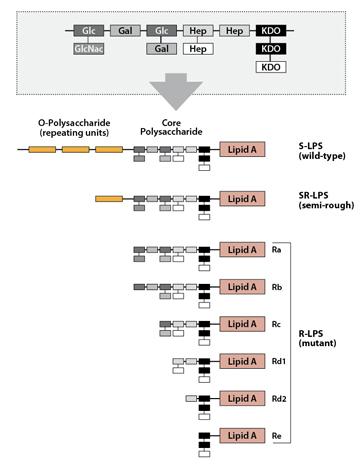LPS from S. minnesota R5 (Rc) TLRpure Sterile Solution
No additional charges, what you see is what you pay! *
| Code | Size | Price |
|---|
| IAX-100-017-C500 | 500 ug | £125.00 |
Quantity:
| IAX-100-017-M001 | 1 mg | £185.00 |
Quantity:
Prices exclude any Taxes / VAT
Stay in control of your spending. These prices have no additional charges to UK mainland customers, not even shipping!
* Rare exceptions are clearly labelled (only 0.14% of items!).
* Rare exceptions are clearly labelled (only 0.14% of items!).
Multibuy discounts available! Contact us to find what you can save.
This product comes from: Switzerland.
Typical lead time: 7-10 working days.
Contact us for more accurate information.
Typical lead time: 7-10 working days.
Contact us for more accurate information.
- Further Information
- Documents
- References
- Related Products
- Show All
Further Information
Alternate Names/Synonyms:
Lipopolysaccharide (LPS) from S. minnesota strain R5 (Rc), R-type (rough/mutant) LPS
Biological Activity:
Optimal concentration is dependent upon cell type, species, desired activation and analysis: 0.05-1.0µg/ml. Does not activate any TLR other than TLR4 as tested up to 50µg/ml in relevant cellular systems (macrophages).
Concentration:
1mg/ml stabilised in sterile, double-distilled water (ddWater), without any additives.
EClass:
32160000
Form (Short):
liquid
Formulation:
Liquid. Colourless clear aqueous solution.
GHS Symbol:
GHS07
Handling Advice:
Do not freeze.To yield a 100µg/ml (1,000-100x) stock solution add 100µl of LPS to 900µl endotoxin-free and sterile ddWater (Cat. No.: IAX-900-002) or 0.9% NaCl Solution (Cat. No.: IAX-900-003) and mix well.Prepare diluted LPS working solutions just prior to use, keep sterile. Ready-made solution is cell culture-grade.
Hazards:
H302, H312, H332
Long Description:
Chemical. Isolated and purified from S. minnesota strain R5. Activation of cells by LPS is mediated by the Toll-like receptor 4 (TLR4). For optimal interaction with LPS, TLR4 requires association with myeloid differentiation protein 2 (MD-2). According to current consensus activation of TLR4 is preceded by the transfer of LPS to membrane-bound (m) or soluble (s) CD14 by LPS-binding protein (LBP). Re-form LPS and lipid A, but not S-form LPS, are capable of inducing TNF-alpha responses also in the absence of CD14. LPS, synthesized by most wild-type (WT) Gram-negative bacteria (S-form LPS), consists of three regions, the O-polysaccharide chain, which is made up of repeating oligosaccharide units, the core oligosaccharide and the lipid A, which harbors the endotoxic activity of the entire molecule. R-form LPS synthesized by the so-called rough (R) mutants of Gram-negative bacteria lacks the O-specific chain. Furthermore, the core-oligosaccharide may be present in different degrees of completion, depending on the class (Ra to Re) to which the mutant belongs. LPS are amphipathic molecules whose hydrophobicity decreases with increasing length of the sugar part. Based upon these differences, S- and R-form LPS show marked differences in the kinetics of their blood clearance and cellular uptake as well as in the ability to induce oxidative burst in human granulocytes and to activate the host complement system.
Other data:
TLRpure™: • Qualified Purity & Activity • High potency TLR4-specific Ligands • Ultrapure (no detectable protein, RNA and DNA) • Tested on TLR4 KO murine macrophages • Standardised Aqueous Sterile Solutions • No purification or hazardous solubilisation • Excellent lot-to-lot consistency
Package Type:
Glass Vial
Precautions:
P261, P301, P312, P302, P352, P304, P340
Product Description:
Activation of cells by LPS is mediated by the Toll-like receptor 4 (TLR4). For optimal interaction with LPS, TLR4 requires association with myeloid differentiation protein 2 (MD-2). According to current consensus activation of TLR4 is preceded by the transfer of LPS to membrane-bound (m) or soluble (s) CD14 by LPS-binding protein (LBP). Re-form LPS and lipid A, but not S-form LPS, are capable of inducing TNF-alpha responses also in the absence of CD14. LPS, synthesized by most wild-type (WT) Gram-negative bacteria (S-form LPS), consists of three regions, the O-polysaccharide chain, which is made up of repeating oligosaccharide units, the core oligosaccharide and the lipid A, which harbors the endotoxic activity of the entire molecule. R-form LPS synthesized by the so-called rough (R) mutants of Gram-negative bacteria lacks the O-specific chain. Furthermore, the core-oligosaccharide may be present in different degrees of completion, depending on the class (Ra to Re) to which the mutant belongs. LPS are amphipathic molecules whose hydrophobicity decreases with increasing length of the sugar part. Based upon these differences, S- and R-form LPS show marked differences in the kinetics of their blood clearance and cellular uptake as well as in the ability to induce oxidative burst in human granulocytes and to activate the host complement system.
Purity:
>99.9%. No detectable DNA, RNA and protein traces.
Signal word:
Warning
Source / Host:
Isolated and purified from S. minnesota strain R5.
Transportation:
Non-hazardous
UNSPSC Category:
Lipopolysaccharides
UNSPSC Number:
12352200
Use & Stability:
Stable for at least 2 years after receipt when stored at +4°C.
Documents
References
A new method for the extraction of R lipopolysaccharides: C. Galanos, et al.; Eur. J. Biochem. 9, 245 (1969) | Electrodialysis of lipopolysaccharides and their conversion to uniform salt forms: C. Galanos & O. L?deritz; Eur. J. Biochem. 54, 603 (1975) | Immunoblot analysis of the R-form lipopolysaccharide from Salmonella S forms: S. Schlecht, et al.; Zentralbl. Bakteriol. 277, 288 (1992) | Isolation and purification of R-form lipopolysaccharides: C. Galanos & O. L?deritz; Methods in Carbohydrate Chem. 9, 11 (1993) | The influence of low growth temperature on the amount of free R lipopolysaccharide, on the expression of R-core determinants and on O-chainlengths in Salmonella S forms: S. Schlecht & H. Mayer; Zentralbl. Bakteriol. 280, 448 (1994) | Guanylate-binding proteins convert cytosolic bacteria into caspase-4 signaling platforms: M.P. Wandel, et al.; Nat. Immunol. 21, 880 (2020) | Ubiquitylation of lipopolysaccharide by RNF213 during bacterial infection: E.G. Otten, et al.; Nature 594, 111 (2021)
Related Products
| Product Name | Product Code | Supplier |
|---|



